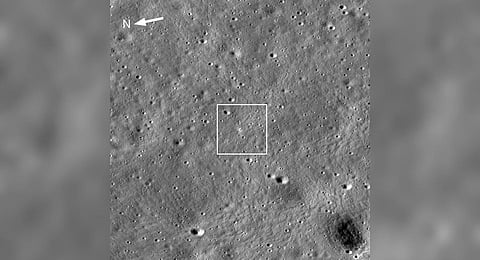

US space agency National Aeronautics and Space Administration (NASA) on Tuesday released a photograph locating the Chandrayaan-3 lander Vikram on the Moon's surface.
NASA's LRO — the Lunar Reconnaissance Orbiter — spacecraft had captured the image of Vikram's landing site on the Moon’s surface.
The lander can be seen in the centre of the image with its dark shadow visible against the bright halo surrounding the vehicle. The image is 1,738 meters wide and has been captured by NASA's Goddard Space Flight Center located at Arizona State University.
According to the US space agency, the LROC (short for LRO Camera) acquired an oblique view (42-degree slew angle) of the lander four days later. The bright halo around the vehicle resulted from the rocket plume interacting with the fine-grained regolith (soil), it added.
Chandrayaan-3 is India's third lunar probe mission and was launched by the Indian Space Research Organisation (ISRO) on July 14, 2023.
Lander Vikram along with rover Pragyan touched down on the Moon on Aug. 23, 2023, making it the first mission to reach the Moon's little-explored south pole. The mission's landing site is located approximately 600 kilometres from the Monn's south pole.
Earlier this week, ISRO announced that Vikram and Pragyan were put to sleep — upon investigating the Lunar surface for two weeks — after the Sun began to set on the Moon.
The rover went to sleep on September 2 and the lander followed suit two days later. Notably, the Moon gets 14 days of continuous sunlight followed by 14 days of darkness.
The ISRO also announced that Vikram had successfully performed a short "hop" — moving by about 40 centimetres closer to the already sleeping Pragyan rover — before it went to sleep.
India's space agency believes that Vikram and Pragyan will wake up again around September 22 when the next lunar day begins. ISRO hopes that the devices will have more exploring capacity left in them.